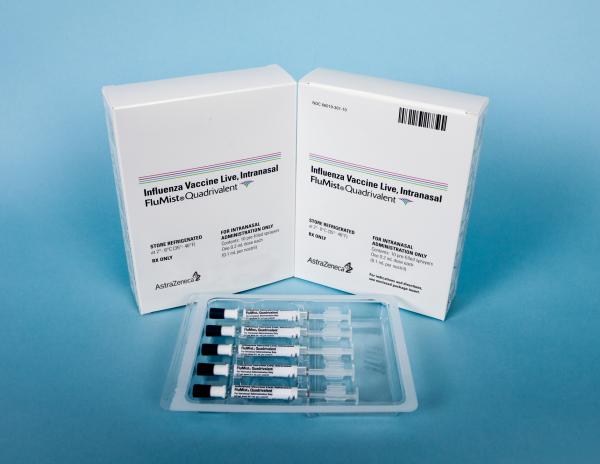Influenza virus vaccine, live Side Effects
Medically reviewed by Drugs.com. Last updated on Jun 21, 2023.
Applies to influenza virus vaccine, live: nasal spray.
In 1976, a number of people who received the “swine flu” influenza vaccine developed Guillain-Barré syndrome (GBS), which is a disease that may cause paralysis. Most of these people were over 25 years of age. Although only 10 out of every one million people who received the vaccine actually developed GBS, this number was 6 times higher than would normally have been expected. Most of the people who got GBS recovered completely.
It is assumed that the “swine flu” virus included in the 1976 vaccine caused the problem, but this has not been proven. Since that time, the “swine flu” virus has not been used in influenza vaccines, and there has been no recurrence of GBS that was associated with influenza vaccinations.
Serious side effects
Along with its needed effects, influenza virus vaccine, live may cause some unwanted effects. Although not all of these side effects may occur, if they do occur they may need medical attention.
Check with your doctor or nurse immediately if any of the following side effects occur while taking influenza virus vaccine, live:
More common
- Chills
- cough
- decreased appetite
- fever
- headache
- muscle aches
- sore throat
- stuffy or runny nose
- tiredness or weakness
Less common
- Earache
- pain or tenderness around the eyes and cheekbones
- redness or swelling in the ear
- shortness of breath or troubled breathing
- sneezing
- tightness of the chest or wheezing
Rare
- Difficulty with breathing or swallowing
- hives
- itching, especially of the feet or hands
- reddening of the skin, especially around the ears
- swelling of the eyes, face, or inside of the nose
- unusual tiredness or weakness (sudden and severe)
Incidence not known
- Anxiety
- bloody nose
- blue or pale skin
- chest pain, possibly moving to the left arm, neck, or shoulder
- confusion
- diarrhea
- dizziness
- drowsiness
- fast heartbeat
- general feeling of illness
- hoarseness
- inability to move the arms and legs
- irritation
- itching
- joint pain, stiffness, or swelling
- nausea
- puffiness or swelling of the eyelids or around the eyes, face, lips, or tongue
- severe headache
- skin rash
- stiff neck and/or back
- sudden numbness and weakness in the arms and legs
- swelling or puffiness of the face
- unusual drowsiness, dullness, tiredness, weakness, or feeling of sluggishness
- unusual tiredness or weakness
- vomiting
- weakness of the muscles in your face
Other side effects
Some side effects of influenza virus vaccine, live may occur that usually do not need medical attention. These side effects may go away during treatment as your body adjusts to the medicine. Also, your health care professional may be able to tell you about ways to prevent or reduce some of these side effects.
Check with your health care professional if any of the following side effects continue or are bothersome or if you have any questions about them:
More common
- Abdominal or stomach pain
- irritability
- loss of appetite
Incidence not known
- Welts
For Healthcare Professionals
Applies to influenza virus vaccine, live: nasal spray.
General
The most common adverse events were nasal congestion, headache, sore throat, and tiredness.[Ref]
Respiratory
Very common (10% or more): Runny nose/nasal congestion (58%), sore throat (28%), cough (14%)
Common (1% to 10%): Wheezing, sinusitis, sneezing
Uncommon (0.1% to 1%): Epistaxis[Ref]
In a clinical trial, among children 6 to 23 months of age, wheezing requiring bronchodilator therapy or with significant respiratory symptoms occurred in 5.9% of FluMist recipients compared to 3.8% of active control (injectable influenza vaccine made by Sanofi Pasteur Inc) recipients (Relative Risk 1.5, 95% CI: 1.2, 2.1). Wheezing was not increased in children 24 months of age and older.[Ref]
Nervous system
Very common (10% or more): Headache (44%), decreased activity/lethargy (18%)
Postmarketing reports: Exacerbation of symptoms of mitochondrial encephalomyopathy (Leigh syndrome), Guillain-Barre syndrome, Bell's Palsy, meningitis, eosinophilic meningitis, vaccine-associated meningitis[Ref]
Other
Very common (10% or more): Tiredness/weakness (26%), fever (16%)
Common (1% to 10%): Hospitalizations, otitis media[Ref]
Musculoskeletal
Very common (10% or more): Muscle aches (17%), abdominal pain (12%)
Common (1% to 10%): Chills[Ref]
Metabolic
Very common (10% or more): Decreased appetite (21%)[Ref]
Hypersensitivity
Uncommon (0.1% to 1%): Hypersensitivity reactions (including anaphylactic reaction, facial edema, and urticaria)[Ref]
Gastrointestinal
Postmarketing reports: Nausea, vomiting, diarrhea[Ref]
Dermatologic
Postmarketing reports: Rash[Ref]
Cardiovascular
Postmarketing reports: Pericarditis[Ref]
More about influenza virus vaccine, live
- Check interactions
- Compare alternatives
- Reviews (15)
- Dosage information
- During pregnancy
- Drug class: viral vaccines
Patient resources
Other brands
Professional resources
Other brands
Related treatment guides
References
1. Product Information. FluMist (influenza virus vaccine, live). Medimmune Inc. 2022.
2. Cerner Multum, Inc. UK Summary of Product Characteristics.
Further information
Always consult your healthcare provider to ensure the information displayed on this page applies to your personal circumstances.
Some side effects may not be reported. You may report them to the FDA.

